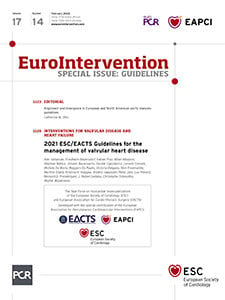This February issue is special because it contains only one article, but what an article! In fact, we are co-publishing the guidelines of the European Society of Cardiology and the European Association for Cardio-Thoracic Surgery on the management of valvular heart disease. We also have a timely editorial by Catherine Otto, first author of the joint American College of Cardiology and American Heart Association guidelines on the same topic, which illustrates the main similarities and differences of the two documents that come from either side of the Atlantic. On this occasion, I would like to thank the European Society of Cardiology for allowing the co-publication of this document in our Journal and the European Association of Percutaneous Cardiovascular Interventions, with its Board and Presidential trio, for their support in carrying out this request. I was part of the Task Force that drafted these guidelines, so I will refrain from personal comments on the contents. Social media, as always, has amplified the discussion around guidelines presented at the European Society of Cardiology Congress – which is positive for their broad dissemination and uptake. I have a feeling that the key principles of this document have been well-received, without divisions that go beyond the normal and fair scientific debate. After all, these are guidelines produced by the European Society of Cardiology together with the European Association for Cardio-Thoracic Surgery, which represents the most exemplary illustration of the Heart Team concept that is interwoven transversally throughout the document. Unsurprisingly, and in general, the guidelines methodology is debated. Catherine Otto, in her Editorial, mentions some aspects that can be improved upon with a view to creating an ever-better process. What I have learned as an author, however, is that the process is more solid than what I, myself, could have expected as a reader (and of course, you can decide to trust me or not). The process is intended to foster debate, representing different opinions and the involvement not only of the multidisciplinary components of the task force, but of countless reviewers as well. Contrary to more conspiratorial views, from what I can testify from my own personal experience, this is not a process that allows overly extreme or potentially biased opinions to take the lead. A methodological review is undertaken and strict rounds of votes with prespecified criteria are required before the several rounds of review process begin. I have seen some who are reluctant to reconcile their positions converge after long discussions in the interest of science and community service. I have no counterevidence to support this, but I would like to think that different people, using the same methodology and moving from the same extremes, would reach the same recommendations. That said, guidelines exist to inform readers about best practices regarding the treatment of certain conditions. It is up to us to read and interpret them for what they are: a practical guide that does not replace decisions based on science, experience and conscience, all in the best interests of our patients.
Supplementary data
To read the full content of this article, please download the PDF.

